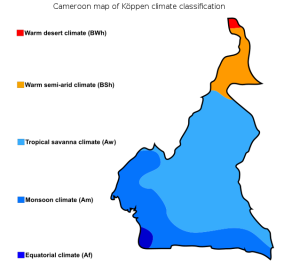Location

Cameroon is a nation that sits at the crossroads of Africa’s western and central regions. Its population, which is made up of people from a wide variety of ethnic groups, is one of the most urban in western Africa (Ardener, 1962). Yaoundé, which is situated in the middle of the country’s south-central region, serves as the nation’s capital.
Language
Cameroon recognizes both English and French as its official languages; nonetheless, French is by far the most widely spoken and understood language (more than 80% of the population) (Ardener, 1962). French and English have long ago supplanted German as the primary languages spoken in the territory that was originally colonized. Cameroonian Pidgin In the regions that were once under British administration, the lingua franca that is spoken is English. Since the middle of the 1970s, Camfranglais, a language that is a combination of English, French, and Pidgin, has been growing in popularity in metropolitan areas (Ardener, 1962). Because the government places an emphasis on promoting bilingualism in both English and French, all official government papers, as well as newly enacted laws and votes, among other things, are drafted and made available in both languages. Cameroon’s government has made it a priority to promote bilingualism, and as a result, six of the country’s eight institutions provide instruction in both French and English.
Climate

The West African Monsoon is the primary factor in Cameroon’s wet season, which runs from May through November and is characterized by the passage of humid air from the Atlantic Ocean over the nation. The months that see the most rainfall are also the months that have the coolest average temperatures. May through June and October through November are the two months that provide the most precipitation to the Southern Plateaus (Ardener, 1962). The dry season in Cameroon runs from December to April and coincides with the months of February through April, which have the highest monthly average temperatures of the year. This season also coincides with the absence of rainfall. The climate in the south of the nation is tropical and humid, with temperatures ranging from 20 to 25 degrees Celsius (depending on height) with the wettest places getting more than 400 millimeters of rainfall per month. Temperatures range from 25-30 degrees Celsius in the semi-arid and dry north of Cameroon, which lies north of latitude 6. This region of the nation often gets monthly precipitation of less than one hundred millimeters (Ardener, 1962).
History
Developments in Cameroon and Europe after World War II led to the country’s attainment of its independence. After independence, the nature and degree of the connection that French Cameroun would have with France was the most important issue in that country (Ardener, 1962). The Cameroon People’s Union which was the first nationalist party, was headed by Felix-Roland Moumie and Reuben Um Nyobe. The Cameroon People’s Union wanted a complete split with France as well as the construction of a socialist economy. The French government actively encouraged alternative political leaders while at the same time suppressing the UPC, which led to a bloody civil war. On the first of the year 1960, independence was declared. Ahmadou Ahidjo won the election to become the first President of the Republic of Cameroon, which took place not long after the country gained its independence (Ardener, 1962). Ahidjo and the Cameroon Union, the party that he leads, have made a commitment to developing a capitalist economy while still maintaining strong connections to France.
The most important decision in British Cameroons was whether or not to continue being a part of Nigeria or to join forces with the newly established Republic of Cameroon. A referendum held in February 1961 under the supervision of the United Nations determined that the southern region of Cameroon should join forces with the region that had been occupied by France to establish the Federal Republic of Cameroon. The northern region of Nigeria decided by ballot to become part of the Nigerian Federation.




